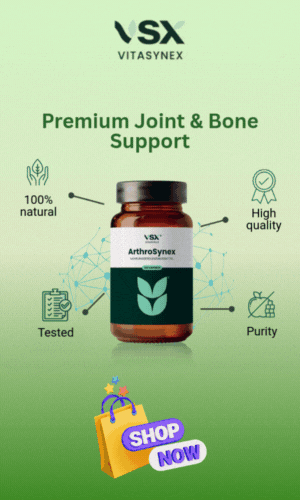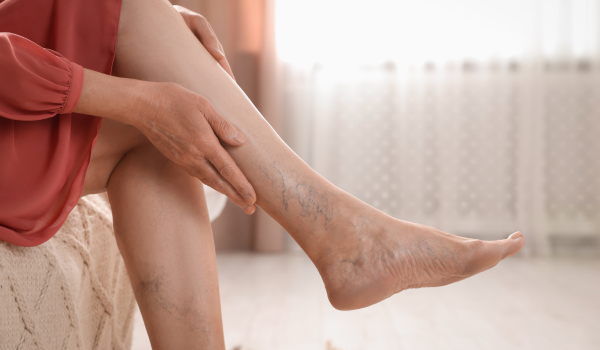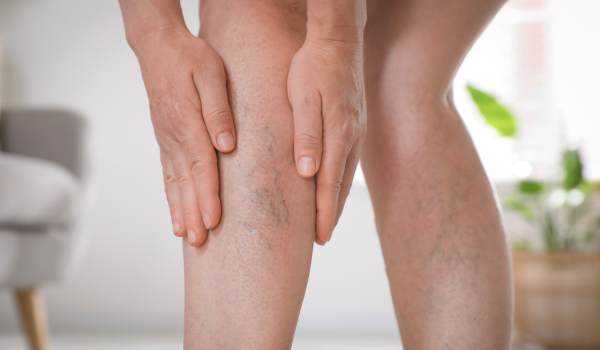.png)
Understanding venous stasis
Chronic venous stasis is a long-term circulatory disorder in which blood pools in the lower legs due to impaired venous return. The condition arises when vein valves—whose job is to prevent blood from flowing backward—become weak or damaged. This leads to sluggish circulation, increased venous pressure, and progressive tissue damage.
People living with chronic venous stasis often face ongoing symptoms like leg swelling, heaviness, skin discoloration, and painful ulcers. These symptoms tend to worsen over time without proper management, making it a challenging and sometimes debilitating condition. However, with appropriate treatment and lifestyle strategies, individuals can live more comfortably and prevent complications.
Daily symptoms
Living with chronic venous stasis means dealing with persistent symptoms that impact daily comfort and mobility. Common signs include:
-
Swelling (edema), especially around the ankles
-
A sensation of heaviness or aching in the legs
-
Discolored, leathery, or thickened skin
-
Itching or burning in the affected areas
-
Open sores or venous ulcers
-
Leg cramps, particularly at night
These symptoms may fluctuate throughout the day, worsening with prolonged standing or sitting and improving with leg elevation or walking.
Common triggers
Certain factors can intensify symptoms or trigger flare-ups in those with venous stasis:
-
Long periods of standing or sitting
-
Warm weather, which can dilate veins and worsen swelling
-
Weight gain or obesity
-
Poor diet or dehydration
-
Lack of exercise
-
Infections or injuries to the skin
-
Inconsistent use of compression therapy
Understanding personal triggers is crucial for effective symptom control and prevention of complications.
Compression therapy
Compression therapy is the foundation of long-term venous stasis management. It works by promoting blood flow, reducing swelling, and preventing ulcers.
Options include:
-
Compression stockings (15–40 mmHg): worn daily to maintain leg pressure
-
Multi-layer bandages: used during ulcer treatment or severe swelling
-
Pneumatic compression devices: for home use in severe cases or when mobility is limited
Consistency is key. Stockings should be worn during waking hours and removed at night, unless directed otherwise by a healthcare provider.
Leg elevation
Raising your legs above heart level for 15 to 30 minutes several times a day can significantly reduce swelling and pressure in the veins.
Try these tips:
-
Prop your legs on pillows while lying on a couch or bed
-
Avoid crossing your legs when sitting
-
Use a reclining chair or ottoman at work if possible
-
Take leg-elevation breaks during long flights or car rides
This simple technique helps blood drain from the legs and reduces discomfort.
Exercise and movement
Staying active helps the calf muscles pump blood back toward the heart. Regular movement strengthens vein function and reduces stagnation.
Recommended activities:
-
Walking: even 15–30 minutes a day improves circulation
-
Leg lifts and ankle pumps: done while seated or lying down
-
Swimming: low-impact and vein-friendly
-
Biking or using a stationary cycle
Avoid high-impact sports that may increase pressure or risk injury to the lower legs.
Skin care routines
Proper skin care prevents infections, ulcerations, and inflammation:
-
Clean your legs daily with gentle soap and lukewarm water
-
Apply fragrance-free moisturizers to prevent dryness and cracking
-
Check for signs of infection (redness, warmth, or oozing sores)
-
Trim toenails carefully and avoid injuring skin while grooming
-
Treat fungal infections (like athlete’s foot) promptly
Your skin becomes more fragile with chronic venous stasis, so prevention is better than treatment.
Diet and fluid balance
A healthy diet and adequate hydration can improve circulation, reduce inflammation, and support vein health.
Nutritional tips:
-
Limit sodium intake to reduce fluid retention
-
Increase fiber to avoid constipation, which raises abdominal pressure
-
Eat antioxidant-rich foods like berries, citrus, leafy greens
-
Include vitamin C and bioflavonoids to support blood vessel strength
-
Stay hydrated with plenty of water, especially if using diuretics
Avoid excessive alcohol and sugar, which can impair circulation.
Weight management
Excess weight places additional strain on leg veins, exacerbating symptoms and increasing the risk of ulcers. Even modest weight loss can relieve symptoms significantly.
Strategies include:
-
Following a calorie-controlled, anti-inflammatory diet
-
Increasing physical activity gradually
-
Seeking support from a nutritionist or medical provider
-
Considering structured weight-loss programs
If obesity is a major contributor, your care team may suggest a medically supervised plan.
Avoiding harmful habits
Certain habits can worsen venous stasis over time and should be avoided:
-
Smoking: damages blood vessels and impairs oxygen delivery
-
Sitting or standing too long: alternate positions frequently
-
Wearing tight clothing or heels: may restrict venous return
-
Skipping compression therapy: leads to rapid symptom flare-ups
Building awareness of harmful patterns is key to staying in control of the condition.
Mental health and support
Chronic conditions like venous stasis can take a toll on mental well-being. Pain, limited mobility, or persistent ulcers can lead to frustration, anxiety, or depression.
Support options include:
-
Talking to a therapist or counselor
-
Joining online or local support groups
-
Reaching out to wound care or chronic illness communities
-
Practicing mindfulness, meditation, or journaling
-
Speaking openly with loved ones about struggles
Mental resilience plays an important role in long-term chronic disease management.
Medical monitoring
Routine follow-ups with a healthcare provider are crucial to managing venous stasis and preventing complications.
Your care team may include:
-
Primary care doctor: monitors overall health and coordinates referrals
-
Vascular specialist: assesses vein function and offers interventions
-
Wound care nurse or clinic: handles ulcer treatment and education
-
Dermatologist: manages skin complications
-
Physical therapist: guides safe movement and rehabilitation
Regular assessments help detect changes early and adapt your treatment plan.
When to seek help
Contact a healthcare provider if you notice:
-
Sudden increase in leg pain or swelling
-
Skin changes (darkening, redness, new ulcers)
-
Signs of infection (fever, warmth, pus)
-
Difficulty walking or standing
-
New varicose veins or worsening symptoms
Early intervention often prevents serious complications like cellulitis, deep vein thrombosis, or non-healing ulcers.
Surgical and interventional care
Some individuals may require procedures to improve vein function or address ulcers:
-
Vein ablation (laser or radiofrequency)
-
Vein stripping for severe varicose veins
-
Angioplasty or stenting
-
Valve repair surgery
-
Skin grafts for non-healing ulcers
These are typically reserved for cases that do not respond to conservative treatments.
Ulcer recurrence
One of the greatest challenges in chronic venous stasis is ulcer recurrence. Even after healing, the skin remains vulnerable.
Prevention strategies:
-
Use compression daily, even after healing
-
Monitor skin daily for new changes
-
Continue leg elevation and activity routines
-
Treat minor wounds promptly
-
Avoid trauma to the lower legs
Consistency and vigilance are the best defenses against recurrence.
Assistive tools
To maintain independence and comfort, certain tools can help:
-
Compression donning aids
-
Shower stools and handrails
-
Special footwear to reduce pressure
-
Mobility aids if walking is difficult
-
Home nurse visits for wound care
These small adjustments can significantly improve quality of life.
Outlook and living well
Though chronic venous stasis is a lifelong condition, it does not have to define your life. With proactive care, consistent habits, and the right support, many people manage their symptoms successfully and avoid major complications.
Adapting your lifestyle, staying informed, and maintaining a supportive healthcare relationship can make a major difference. Empowerment begins with education and action.

.png)
.png)
.png)
.png)
.png)
.png)
.png)
.png)
.png)



